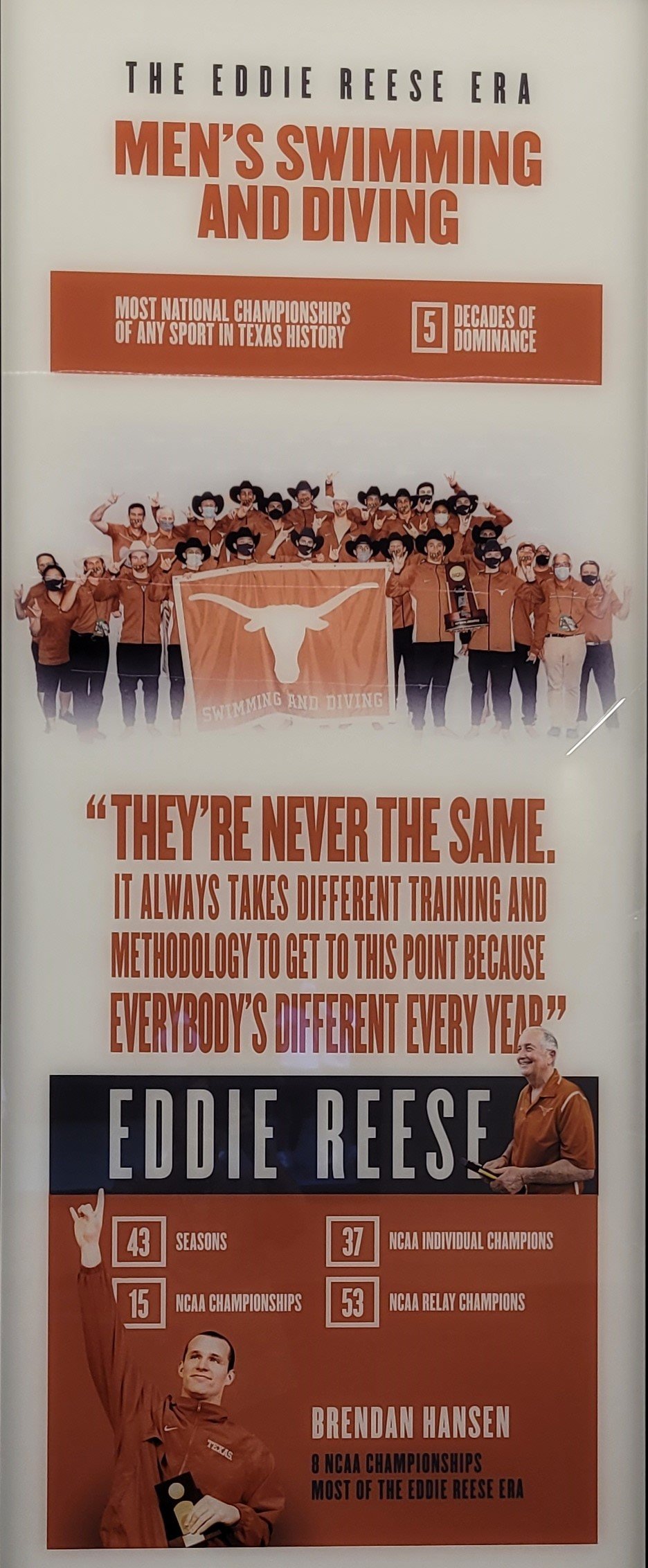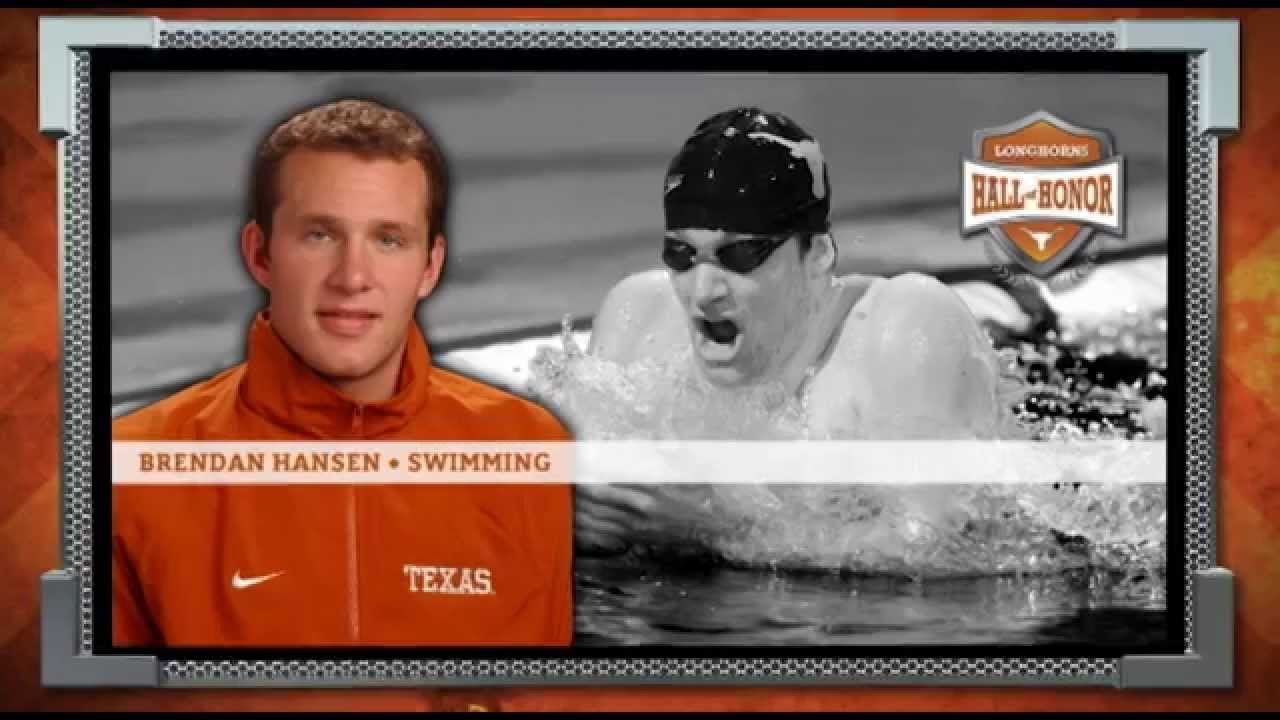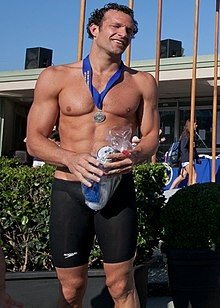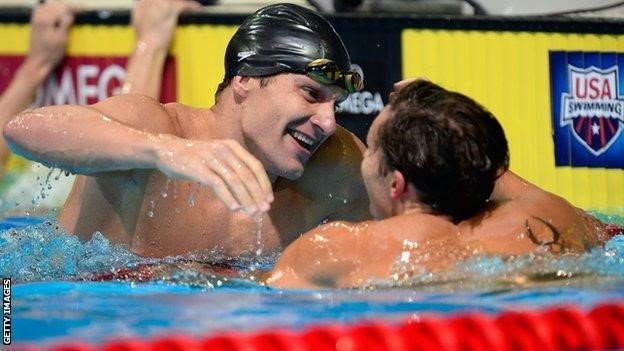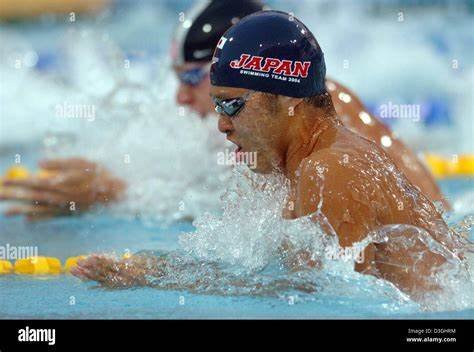Brendan Hansen’s oral history is sponsored by Working Exes For Texas Swimming
"Most American athletes dream of being "All" something. All district, state, conference and/or All-American. The word "ALL" confirms the skills, talent, and disciplines necessary to be recognized as a superior athlete. But one of the most powerful and significant confirmations of talent does not include the word "All." It is the title "Olympic Champion."
An accolade officially recorded and honored for eternity as the best in the world. Several Longhorns have reached the top of the pedestal as Olympian champions. Brendan Hansen is one of them. But his story does not end with the gold medal; it begins there.
Read, look, and listen, as Brendan shares his story via podcast, text, and photos.
Brendan is a leader in any endeavor he chooses. He has proven his leadership skills many times over his 15 years on the U.S. National team breaking swimming records is the reason he is famous, and he set many records from childhood to 30 years of age.
Below is the Oral history of Longhorn national champion and gold medal Olympian Brendan Hansen. Click on the white triangle enclosed in the black rectangle to start the adventure chronicling one of the greatest Longhorn athletes of all time.
Brendan's podcast is below in a black rectangle.
Hansen and Coach Reese
Brendan Hansen as a Longhorn
Hansen is well known for his unique style of breaststroke, which incorporates a much narrower kick than most other swimmers.
After not making the Olympic team in 2000, he said, “There were a few days when I didn’t see the light at the end of the tunnel. It was hard,” “But I’m going to use it as a positive. You can’t regret what happened in the past, but you can use it as motivation for myself and my teammates. I’m a man on a mission.” Lessons were learned, and he was a driven man. He had no doubt that he would make the team at the next Olympic trials. He did!
Coach Reese said, “His swimming at the (Olympic) Trials was a great indicator of his ability.” “But to get third in both events would floor most people. Not Brendan. He took no time to get back on his horse and get back to work.”
After failing to make the Olympic team, he was off to Texas on a scholarship. Hansen didn’t waste time under Coach Reese in setting the benchmark for how to swim the breaststroke. He was a member of two Longhorn National teams and still is the only male breaststroker to remain undefeated in the 100 and 200 breaststrokes at the NCAA Championships during all four years of his eligibility.
His first breakout as the best in the world was at the 2001 World Championships in Fukuoka, Japan. While not considered a favorite, Hansen captured the gold medal with a championship-record time of 2:10.69.
Brendan the Olympian
Named Captain nine times, two of which as Olympic Team Captain (’08, ’12).
2004 Olympic Games, gold medal in the 400m, silver medal in the 100m breaststroke, and a bronze medal in the 200m breaststroke
2008 Olympic Games, gold medal in the 4x100m medley, 4th place in the 100m breaststroke
2012 Olympic Games, gold medal in the 4x100m medley relay, bronze in the 100m breaststroke
Career Highlights
2007 World Championships, gold in the 100m breaststroke, silver medal in the 50m breaststroke
2006 Pan Pacifics, gold in the 100m breaststroke, 200m breaststroke, and 400m MR
2005 World Championships, gold medal in the 100m breaststroke, 200m breaststroke, and 400m MR
Hansen is a former world record holder in the 100- and 200-meter breaststroke (long course), as well as the 4×100-meter medley relay (long and short course).
The Dolphin Kick Controversy of Kosuke Kitajima vs. Brendan Hansen
Some of the following article is either captured or paraphrased from a story about Kosuke Kitajima and Brendan Hansen titled “Dolphin Kick by JOHN LOHN - EDITOR-IN-CHIEF
Certain athletes will be forever linked. On the basketball court were Larry and Magic. In the ring, it was Ali vs. Frazier. On the grass of Wimbledon, it was Borg vs. McEnroe. In swimming, it is Hansen vs. Kitajima.
This is how close the rivalry was between Kosuke and Brendan.
At the 2004 Olympics, Hansen finished second in the 100 breaststroke losing to Koshke Kitajima. Indeed, a neck-and-neck showdown is what evolved. Stroke for stroke over two laps, Hansen and Kitajima battled. As they touched the wall and looked to the scoreboard, it was shown that Kitajima got to the touchpad first, his time of 1:00.08 narrowly edging the 1:00.25 of Hansen.
At the realization of his triumph, Kitajima let out several primal screams, much to the dismay of Hansen. But the screaming was just starting.
Hansen didn’t cry foul at the end of the race. For one, that wasn’t his style. He blamed only himself for not claiming victory.
There was controversy surrounding KItajima’s win in the 100 breaststroke.
A move by Kitajima set off a charge of cheating by Hansen’s teammate and friend, Aaron Peirsol, that resulted in a rule change for the stroke. The U.S. team agreed that Kitajima used an illegal dolphin kick, but the Olympic officials declined to issue a penalty.
Sprinter Jason Lezak voiced his displeasure over Kitajima’s tactics. Peirsol, who swept the backstroke events at the Athens Games, went on the offensive almost immediately after the race. “He knew what he was doing,” Peirsol said of Kitajima. “It’s cheating. Something needs to be done about that. It’s just ridiculous. You take a huge dolphin kick that gives you extra momentum, but he knows you can’t see that from underwater. He’s got a history of that. Pay attention to it.”
Experts in the sport, primarily coaches, figured the power of a dolphin kick was good for up to two-tenths of a second per lap, meaning Kitajima’s usage easily provided the winning difference over Hansen. But none of the deckside judges saw or were willing to call the violations, and because video replay was not used in swimming, technology could not be employed. With no room to file a protest, Hansen was out of luck. He was also admirable in the way he handled the situation.
Underwater cameras used for television purposes showed that Kitajima had twice violated a rule of the stroke. He was shown using a downward dolphin kick at the start of the race and again after the turn at the 50-meter mark. At the time, the event did not allow for any dolphin kicks, unlike the other strokes in the sport.
Hansen vs Kitajima
“It would be a big deal for an official to come out and to disqualify somebody,” Hansen said. “I can only account for my actions, and I know exactly what I did in my race. Everything else, I hope the officials who are sitting right next to me will take care of that. They are not there to have a front-row seat and watch the Olympic Games. They’re there to take care of the rules. I believe that’s what they do.
Kitajima said, “when I heard the comments by Peirsol, I was really surprised because I always try to have fair competition. I’m always trying my best within the regulations. I have never, ever been cautioned by the official judges.”
Three days after claiming his controversial gold medal in the 100 breaststroke, Kitajima left no doubt about his dominance in the 200 breaststroke, winning by more than a second over Hungarian Daniel Gyurta, with Hansen taking the bronze medal.
The controversy sparked by the final of the 100 breaststrokes in Athens did not dissipate and forced a rule change to the sport. Almost a year after Kitajima’s clouded win, FINA, the international governing body of swimming, decided to amend its regulations by allowing athletes a single dolphin kick at the start of each race and after each turn. Basically, rather than placing the onus on officials to enforce the rules, FINA took the easy way out. Controversy on the Dolphin kick still remains, but FINA refuses the implementation of an underwater-camera review system.
In the 2008 Olympics did not receive an individual medal, but he did help the U.S. prevail in the medley relay. Hansen retired after the Beijing Games, content to explore other endeavors.
2012 London Olympics
Eventually, the competitive urge got the best of Hansen, and he returned to action in time to qualify for the 2012 Olympics in London. With lower expectations, Hansen competed without pressure taking the last qualifying spot for the finals in lane 8 but managing to win a bronze 🥉 medal. One that he cherishes for a comeback saying the medal was “the shiniest bronze medal ever.” The medley relay on the last day of the meet saw Hansen win another gold with Team USA, and Kitajima picked up silver with his Japanese teammates.
At the end of their final duel, Hansen and Kitajima put aside the digs that had been exchanged through the years and paid each other respect. “We had a good run against each other,” Hansen said.
Life on the other side
After leaving the competitive side of the sport after the 2012 Olympics, Brendan Hansen was the head coach of the Austin Swim Club. As a coach, Hansen’s athletes were world-class swimmers Dakota Luther, Matthew Willenbring, Josh Artmann, and Kendall Shields. As a Coach, Brendan preached that technique, and a team-driven atmosphere were the keys to fast swimming.
He would later go on to serve on the Board of Directors of the USA Swimming Foundation before joining the USA Swimming staff in July 2019.
Presently Brendan is the DIRECTOR of TEAM SERVICES. Brendan Hansen brings decades of competitive and coaching experience to his role as USA Swimming’s Director of Team Services. Hansen oversees a team of seven team services advisors who aim to serve and support the members of their respective zones.
Brendan Hansen is also a great public speaker. Randy Allen says, “ I traveled with Brendan while rolling out our product line; I watch Brendan captivate many audiences with his vast experiences, both personal an professional. “ “He brings out the best in everyone.” He was a great spokesman for our product. .




